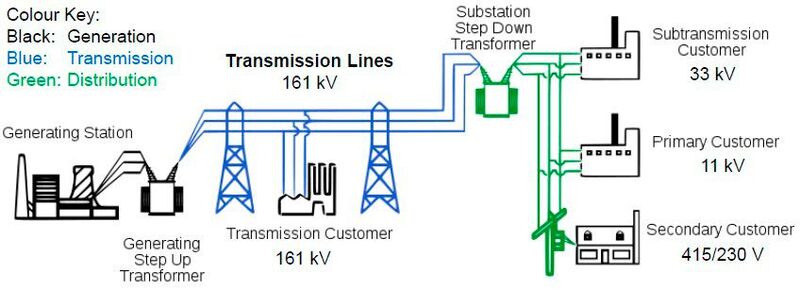Basics of an electrical power transmission system
Electrical Power
Basics of an electrical power transmission system
Electrical power transmission involves the bulk movement of electrical energy from a generating site, such as a power station or power plant, to an electrical substation where voltage is transformed and distributed to consumers or other substations.
 Electric transmission and distribution (T&D) technologies include components used to transmit and distribute electricity from generation sites to end users.
Electric transmission and distribution (T&D) technologies include components used to transmit and distribute electricity from generation sites to end users.
(Source: Unsplash)
The interconnected lines that enable the movement of electrical energy are known as a “transmission network,” and these form an electrical power transmission system—or, as it is more commonly known, the power grid.
Primary transmission
 A basic representation of a power grid, with transmission highlighted in blue.
A basic representation of a power grid, with transmission highlighted in blue.
(Source: Solo Nunoo via ResearchGate)
When it is generated at a power station, electrical energy will typically be anywhere between 11kV and 33kV. Before it is sent to distribution centers via transmission lines, it is stepped up using a transformer to a voltage level that can be anywhere between 100kV and 700kV or more, depending on the distance that it needs to be transmitted; the longer the distance, the higher the voltage level.
The reason electrical power is stepped up to these voltage levels is to make it more efficient by reducing the I2R losses that take place when power is transmitted. When voltage is stepped up, the current reduces relative to the voltage so that power remains constant, thus reducing these I2R losses.
This stage is known as primary transmission—the transfer of a large quantity of electrical power from the initial generating station to the substation via overhead electrical lines. In some countries, underground cables are also used in cases where transmission takes place over a shorter distance.
Secondary transmission
When electrical power reaches a receiving station, the voltage is stepped back down to a voltage typically between 33kV and 66kV. It is then sent to transmission lines emerging from this receiving station to electrical substations closer to “load centers” such as cities, villages, and urban areas. This process is known as secondary transmission.
When electrical power reaches a substation, it is stepped down once more by a step-down transformer to voltages closer to what it was generated at—usually around 11kV. From here, the transmission phase graduates to the distribution phase, and electrical power is used to meet demand from primary and secondary consumers.
Follow us on LinkedIn
Follow us here!
(ID:46489228)















![Toni Kroos là ai? [ sự thật về tiểu sử đầy đủ Toni Kroos ]](https://evbn.org/wp-content/uploads/New-Project-6635-1671934592.jpg)


